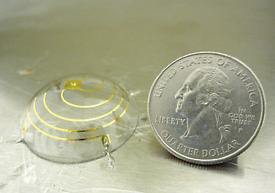Engineering researchers at U-M have found a way to mass-produce antennae so small that they approach the fundamental minimum size limit for their bandwidth, or data rate, of operation.
This could lead to new generations of wireless consumer electronics and mobile devices that either are smaller or can perform more functions. The antenna typically is the largest wireless component in mobile devices. Shrinking it could leave more room for other gadgets and features, says Anthony Grbic, an associate professor in the Department of Electrical Engineering and Computer Science.

A hemisphere-shaped antenna developed at U-M has the capacity to be mass produced and could lead to improvements in wireless consumer electronics. Photo by Carl Pfeiffer.
Grbic and Stephen Forrest, a professor in the Department of Materials Science and Engineering and Department of Physics, led the development of the hemisphere-shaped antennae, which can be manufactured with innovative imprint processing techniques that are rapid and low cost. The finished product is 1.8 times the fundamental antenna size limit established in 1948 by L.J. Chu. The dimensions of this limit vary based on an antenna’s bandwidth.
“Ever since the Chu limit was established, people have been trying to reach it. Standard printed circuit board antennas don’t come close. Some researchers have approached the limit with manually built antennas, but those are complicated and there’s no efficient way to manufacture them,” Grbic says.
“We’ve found a way to reduce the antenna’s size while maximizing its bandwidth, using a process that’s amenable to mass production.”
The researchers’ prototype operates at 1.5 gigahertz, in the frequency range of WiFi devices as well as cordless and mobile phones. The antenna is 70 percent efficient and 10 times smaller than conventional antennae, Grbic says. It has three times the conductivity of similar devices produced by 3-D ink-jet printing techniques, a process that serially writes the antenna geometry.
This new method is a very general process, says Carl Pfeiffer, a doctoral student in the Department of Electrical Engineering and Computer Science and first author of a paper on the work being presented at the 2011 IEEE International Symposium on Antennas and Propagation.
“It can be used to fabricate antennas that are of a wide variety of sizes, shapes, frequencies and designs,” Pfeiffer says. “Basically if you tell me the data rate that is required for a particular application, I can make an antenna that does this while at the same time being as small as possible.”
Beyond consumer electronics, this work could be useful in wireless sensing and military communications. Wireless sensor networks could be used for environmental monitoring or surveillance.
The prototype was made in the College of Engineering’s Lurie Nanofabrication Facility.
The paper is titled, “Novel Methods to Analyze and Fabricate Electrically Small Antennas.”
Forrest also is the William Gould Dow Collegiate Professor of Electrical Engineering and the university’s vice president for research.
U-M has licensed certain rights involved in this research to Universal Display Corp. Forrest holds an equity interest in, serves on the scientific advisory board and is a consultant for the company.

